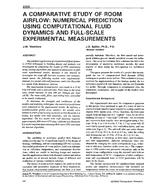Description
The potential application of computational fluid dynamics (CFD) techniques to building design and analysis was investigated by comparing the results of CFD simulations using varying algorithms and numerical parameters to full-scale experimental results. Because it was desired to investigate the trade-offs between accuracy and computational speed, the following models were implemented – laminar, K-E (kappa epsilon) model with wall functions, and a low-Reynolds K-E model (Lam-Bremhorst version). The experimental measurements were made in a 15 by 9 by 9 ft room with a sidewall inlet. Flow rates in the room were varied between 15 and 100 air changes per hour (ACH). The room walls, floor, and ceiling were controlled to be nearly isothermal. To determine the strengths and weaknesses of the models and modelling techniques, the numerical predictions were compared to the experimental results. By defining a nondimensional global error number, the models were ranked in order of decreasing accuracy as low-Reynolds K-E model, K-E model with wall functions, and the laminar algorithms. The K-E model with wall functions required approximately 50% more CPU time, while the low-Reynolds K-E model required approximately 80% more CPU time than the laminar algorithm.
KEYWORDS: rooms, air flow, calculating, models, experiment, designing, measuring, temperature, walls, fluid flow, comparing.
Citation: ASHRAE Trans. 1993, vol. 99, Part 2, Paper number 3705, 144-157, 11 figs, 3 tabs, 24 refs.
Product Details
- Published:
- 1993
- File Size:
- 1 file , 1.3 MB
- Product Code(s):
- D-17396




